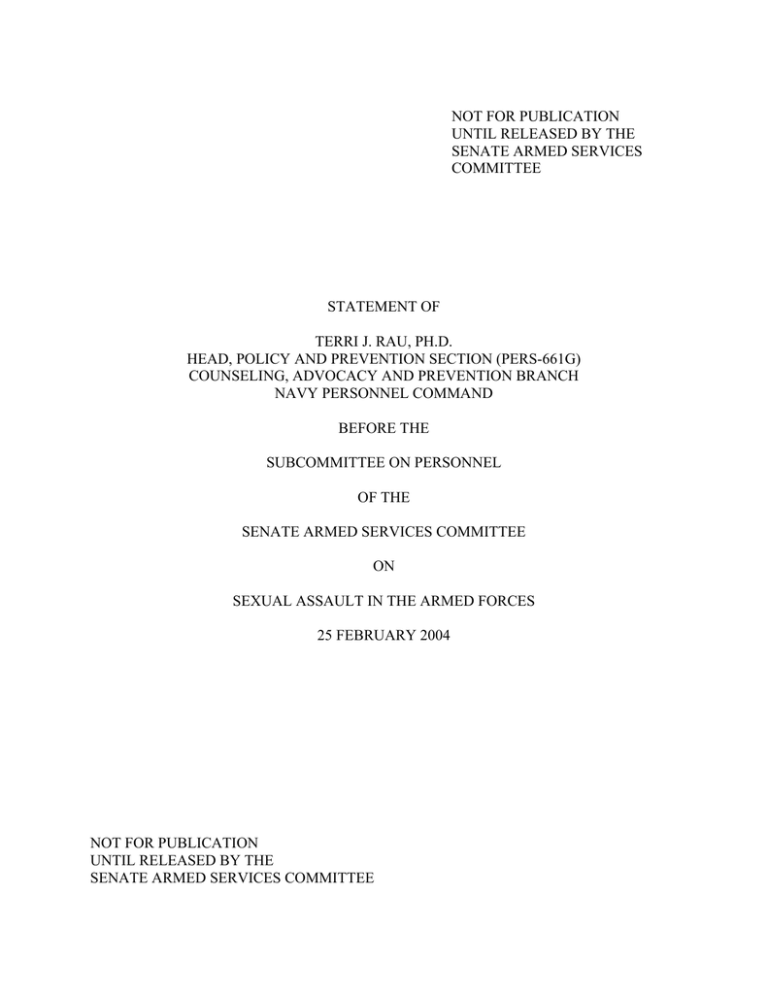
NOT FOR PUBLICATION
UNTIL RELEASED BY THE
SENATE ARMED SERVICES
COMMITTEE
STATEMENT OF
TERRI J. RAU, PH.D.
HEAD, POLICY AND PREVENTION SECTION (PERS-661G)
COUNSELING, ADVOCACY AND PREVENTION BRANCH
NAVY PERSONNEL COMMAND
BEFORE THE
SUBCOMMITTEE ON PERSONNEL
OF THE
SENATE ARMED SERVICES COMMITTEE
ON
SEXUAL ASSAULT IN THE ARMED FORCES
25 FEBRUARY 2004
NOT FOR PUBLICATION
UNTIL RELEASED BY THE
SENATE ARMED SERVICES COMMITTEE
Introduction:
Mr. Chairman and subcommittee members, I greatly appreciate the opportunity to share
with you my perspective on the Navy’s efforts to increase awareness, prevent, and respond to
sexual assault. It has been my privilege for the past 10 years to work with and for the Navy, as it
tackles this difficult challenge.
I am a Clinical Psychologist and have devoted my professional career to understanding
and working in the fields of family violence and sexual assault. I first became aware of the
Navy’s efforts in these areas when I began working in military mental health. Having worked
for a number of years within the civilian sector of a metropolitan area, I was immediately
impressed with the Navy’s forethought and progressive policies, practices and procedures. My
respect only grew as I gained understanding of the sometimes conflicting challenges Navy
commanders face every day. I have only passing knowledge and no personal experience
working for the other military services. However, I bring to this hearing the perspective of
having worked both outside and within the Navy system to improve our society’s understanding
of, and response to, family violence and sexual assault.
I thank you for your leadership and attention to this issue. We welcome the opportunity
in the Navy to self-examine, share information on lessons learned, and improve our response to
sexual assault.
Background:
It is important that the Navy Sexual Assault Victim Intervention (SAVI) Program is well
grounded in current scientific knowledge and best practice. Toward this end, I believe it is
useful to examine what is known about sexual assault in college populations. Comparisons to
the Navy culture and population are perhaps appropriate in that colleges offer a relatively closed
community of predominantly young people who are experiencing the freedom and responsibility
of adulthood for the first time and who live in close, often co-educational quarters. Data from
the National College Women Sexual Victimization Study is very informative. This was a
telephone survey of almost 4500 women attending 2 and 4-year colleges in 1996. The study
used a method similar to the National Crime Victimization Survey, with the exception of asking
more behaviorally specific sexual victimization screening questions. The results were striking.
The rate of attempted or completed rape was 27.7 per 1000 college females, a rate about 20 times
that of the general population. Less than 5% of college women reported their completed or
attempted rapes to law enforcement and less than half of the women who were raped by legal
standards defined the incident as such. Victims of attempted or completed rape knew their
offenders nine out of ten times. Most of the sexual assaults occurred at night, in living quarters.
Factors that consistently increased the risk of sexual victimization for these women were:
frequent alcohol intoxication, being single, and prior sexual assault victimization. Assuming that
the parallel is not unreasonable, this data suggests that the military services face significant
challenges in preventing and responding to sexual assault.
Program and Process:
To complement Admiral Mullen’s testimony, I would like to provide more detail on how
SAVI is structured and functions and then speak to program effectiveness. Admiral Mullen’s
written testimony already addresses current initiatives and program improvements. SAVI was
established to provide a Navy-wide, comprehensive, standardized, victim-sensitive system to
prevent and respond to sexual assault. The program epitomizes the coordinated community
response in that it provides a series of overlapping protocols between key responders that
ultimately increases the effectiveness of all responders. The program operates at both the
installation and command level, which is essential for success given the Navy’s operational
tempo and mission.
At the installation level, the SAVI Coordination Committee includes, but is not limited
to, representatives from medical, legal, security, Naval Criminal Investigative Services (NCIS),
Chaplains and Fleet and Family Support Centers (FFSC). The Coordination Committee is
responsible for ensuring that sexual assault issues are addressed and all first responders are
working together effectively as a team. The SAVI Program Coordinator is designated by the
installation commander and usually works within the FFSC. SAVI Coordinators provide local
program oversight and management, to include administration, management and supervision of
military advocates, providing and facilitating SAVI/sexual awareness required training to all
components, victim advocate training, and insuring availability of victim intervention services.
All installations are required to provide 24/7 advocacy services for sexual assault victims, either
through the use of trained military volunteers, community sexual assault resources or a
combination thereof. Advocates respond immediately to calls from the victim, security, medical,
chief duty officer, NCIS or other official sources. SAVI advocates provide emotional support,
assistance and information, help secure basic needs, and accompany victims to all interviews,
examinations or legal proceedings if requested. SAVI advocates provide assistance to both
active duty and adult family member victims. When requested, professional intervention
services are available for victims through the FFSC, military mental health or referral to
available civilian resources.
With respect to individual commands, the SAVI Point of Contact (POC) is designated by
the commander to serve as the command’s SAVI expert, implement and coordinate all required
command training, and maintain current information regarding base or community victim
services and resources for command members. In addition to SAVI POC’s, SAVI Command
Representatives are mature, responsible individuals who are designated by the commander after
a sexual assault has been reported. They serve as a liaison between the victim or their support
system and the command. Command Representatives provide a direct line of communication
for the victim to the command executive level, enabling victims to voice safety concerns, express
preferences and receive information on the command’s response to the assault. The role of the
Command Representative is generally more supportive and their responsibilities extend well
beyond those of the Command Victim Assistance Coordinator, whose role is more
administrative. All commands are also required to have a Data Collection Coordinator who is
responsible for collecting and tracking initial, follow-on and final data regarding all alleged
sexual assaults involving either active duty, adult family members or occurring on Navy
property. This information is forwarded in Unit SITREPs and is collected from key responders
to avoid revictimization. SAVI required data is forwarded to headquarters for the purpose of
analyzing trends to assess program operation and guide program development and, as such, does
not contain any identifying information with respect to either the victim or offender.
Maximizing victim privacy is paramount within the SAVI Program. Deploying/afloat
commands are encouraged to have trained military advocates aboard to respond to sexual
assaults that occur away from Navy installation resources. Over 300 deploying commands had
trained advocates aboard this year. Anecdotally, our active duty advocates often become the
most vocal supporters of SAVI. It is important to note that the SAVI instruction specifically
provides protocols for afloat commands, both when cases are reported in port and when
deployed, as well as commander’s guidelines for responding to sexual assault.
Awareness and prevention education is a key component within the SAVI Program.
Training on sexual assault awareness and SAVI is provided at every initial accession point,
throughout the leadership continuum schools, and during Navy-wide, annual mandatory General
Military Training (GMT). We have specifically taken onboard the college data described above
in developing the mandatory GMT materials for FY-05. I have personally briefed SAVI, on a
recurring basis, to prospective commanding and executive officers, Command Master Chiefs and
other senior enlisted. I have generally found them to be receptive and committed to effective
leadership in this difficult area. The FFSC 2002 Leadership Survey clearly indicated that
command leadership, at all levels, recognizes the need for assistance outside the command to
successfully respond to sexual assault. Increasing general awareness and gaining command
leadership support of SAVI requires ongoing effort, due largely to leadership rotation and
accession, but is critical to program success. SAVI functions most effectively in commands
where strong zero tolerance messages are communicated from the top down, there is leadership
by example, and there are clear expectations with regard to compliance with Navy standards of
conduct and SAVI requirements.
Although I understand the importance of an effective criminal justice response to sexual
assault, both to enhance empowerment and resolution for victims and to insure community
safety, I am as concerned with ensuring that there is readily available victim support, advocacy
and, when necessary, professional intervention. Sensitivity to the sexual assault victim is a
strong theme within SAVI and is evident in Navy policies that:
•
guard victim privacy by limiting “need to know” personnel and providing
mechanisms for data collection and tracking that do not rely on victim identity,
•
reassure victims that reporting was the right thing to do while affording them choice
with regard to participating in military law enforcement investigation or reporting
sexual assaults that fall under civilian jurisdiction,
•
provide multiple avenues to receive information about their rights under applicable
law and the Victim and Witness Assistance Program, and
•
consider, if at all feasible, the victim’s preference regarding reassignment if the
alleged offender is from the same command.
Program Effectiveness:
SAVI is a vital and active program within FFSCs. In FY-02, FFSCs reported over
107,000 SAVI-related contacts including awareness and prevention education activities,
command consultation, victim assistance and advocacy, information and referral, GMT, and
command leadership training.
In a 2002 survey of SAVI patrons who received prevention training/GMT or advocacy
services, there were no negative program ratings with respect to user satisfaction. Outcomes for
those who received advocacy services were particularly striking. Over 95% of respondents
indicated that SAVI showed concern for sailors and their families, while the program contributed
to their overall quality of life and their readiness for 88% and 78%, respectively. All respondents
who received advocacy services indicated that SAVI helped them cope at least somewhat with
the sexual assault and 88% indicated that it helped quite a lot or more.
Finally, I would like to mention that SAVI has been recognized for its efforts by several
agencies outside of the Department of Defense. In 1996, the National Organization of Victim
Assistance presented SAVI with a Distinguished Service to Victims of Crime Award. SAVI
received a Certificate of Appreciation from the Department of Justice, Office for Victims of
Crime in 1999, in recognition of the program’s dedication to victims’ rights.
Summary and Conclusion:
While SAVI lays a solid foundation, we recognize that there is always room for
improvement in our efforts to prevent sexual assault and to offer the best possible support, safety
and justice for victims, their family members and the Navy community. Thank you for holding
these hearings and for your continued support as we pursue this important challenge. I look
forward to answering your questions.






